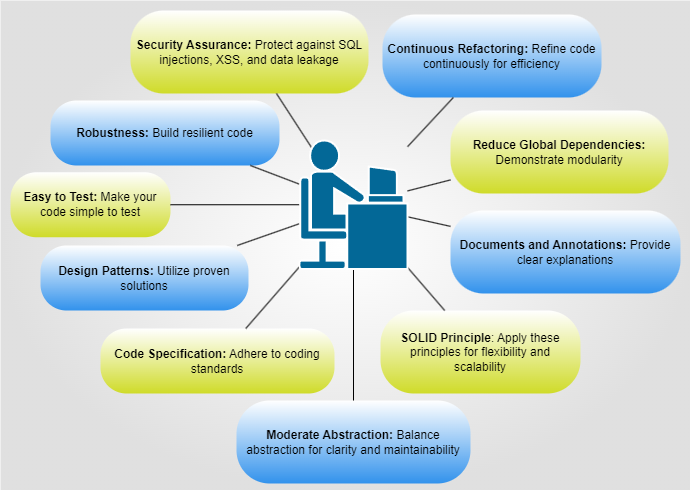Mastering the Art of Code Reviews: 10 Good Coding Principles
June 08, 2024
Ever been in a code review and felt that your work truly stood out? In dev teams, the code review process is where we get to showcase our skills, learn from peers, and contribute to a collective standard of excellence. Recently, I came across this insightful infographic from ByteByteGo on '10 Good Coding Principles,' and it perfectly captures what makes our code reviews stand out.
Let’s break down these principles that not only improve our coding but also make our PRs sparkle:

1. Security Assurance
Show your reviewers that you’ve thought ahead. Protect against SQL injections, XSS, and data leakage to ensure robust security. Highlighting these measures demonstrates your commitment to creating safe and secure applications. Secure code not only protects sensitive data but also builds trust with users and stakeholders. Implementing best practices like input validation, proper authentication, and encryption can set your code apart in a review.
2. Continuous Refactoring
Impress by continuously refining your code. A cleaner, more efficient codebase is always appreciated. Regular refactoring not only enhances readability but also ensures that the codebase evolves gracefully over time. This includes eliminating dead code, simplifying complex logic, and improving performance. It shows that you are proactive in maintaining the health of the codebase and are not afraid to revisit and improve your previous work.
3. Reduce Global Dependencies
Demonstrate modularity. Reducing global dependencies makes your code more maintainable and easier to work with. This principle helps in isolating different parts of the code, making it more adaptable to changes. By minimizing global state and using dependency injection, you can create more testable and robust systems. This approach also makes it easier for other developers to understand and modify individual components without unintended side effects.
4. Design Patterns
Utilize proven solutions. Design patterns aren't just theoretical—they're practical tools that solve common problems efficiently. Applying them correctly can significantly improve the structure and clarity of your code. For example, using the Singleton pattern for managing shared resources or the Observer pattern for implementing event handling can make your code more modular and easier to extend. Design patterns can also facilitate better communication among team members by providing a common vocabulary for discussing solutions.
5. Code Specification
Adhere to coding standards like PEP 8 for Python or Google Java Style. Consistent, well-documented code is easier to review and maintain. It shows professionalism and a deep understanding of industry best practices. Using tools like linters and formatters can help enforce these standards automatically. Consistent code style reduces cognitive load for reviewers and collaborators, making it easier to focus on the functionality and logic of the code.
6. Documents and Annotations
Provide clear explanations. Good documentation and comments can clarify your logic and decision-making processes. This transparency helps reviewers understand your code quickly and thoroughly. Effective documentation includes inline comments, API documentation, and architectural overviews. It can guide new team members and future maintainers through your codebase, ensuring that your thought process and design decisions are preserved.
7. Robustness
Build resilient code. Handling input errors, disk failures, and potential attacks shows foresight and thoroughness. Robust code is a testament to your ability to anticipate and mitigate potential issues. This involves writing defensive code that can gracefully handle unexpected situations without crashing. Techniques like input validation, error handling, and logging are essential for creating systems that can operate reliably in real-world conditions.
8. SOLID Principles
Apply these principles to make your code flexible and scalable. It’s a hallmark of good design and forward-thinking. Following SOLID principles ensures that your code is well-organized and prepared for future growth. The SOLID principles (Single Responsibility, Open/Closed, Liskov Substitution, Interface Segregation, and Dependency Inversion) provide a foundation for creating code that is easy to understand, extend, and maintain. These principles promote separation of concerns and reduce coupling, making your codebase more modular and adaptable to change.
9. Moderate Abstraction
Balance abstraction. Too much can be confusing, too little can be cluttered. Aim for clarity and maintainability. Finding the right level of abstraction makes your code easier to understand and manage. Abstraction helps in hiding complexity and exposing only the necessary details, but over-abstraction can lead to unnecessary complexity. Strive for a balance where your abstractions simplify the code without obscuring its functionality or making it difficult to navigate.
10. Easy to Test
Make your code simple to test. Low complexity, automated testing, and efficiency are key to a smooth review process. Testable code not only ensures quality but also makes it easier for others to verify your work. Writing unit tests, integration tests, and using test-driven development (TDD) practices can help ensure that your code behaves as expected. Code that is easy to test often follows good design principles and is less likely to contain hidden bugs.
By incorporating these principles, your pull requests won't just be functional—they’ll be exemplary. They reflect a thoughtful, professional approach to coding that not only meets but exceeds standards.
